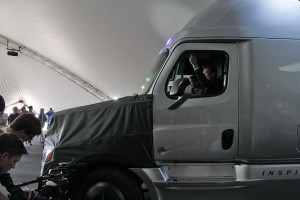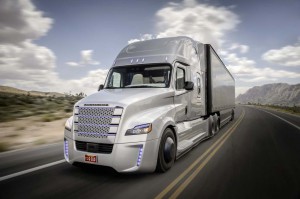Daimler AG expects to begin rolling out its semi-autonomous heavy truck on German highways “within the next few weeks,” according to a senior executive.
The maker first began testing its Freightliner Inspiration truck in Nevada earlier this year, and hopes to put the technology into production around the end of the decade. But where it would go on sale first has been a question even the automaker says it can’t yet answer as most countries still don’t have in place the laws that would allow the use of hands-free vehicles.
“We are positive that we will get approval for tests on German motorways within the next weeks,” Daimler board member Wolfgang Bernhard, head of the maker’s truck operations, told the Frankfurter Allgemeine Sonntagszeitung. Once approval is granted, Bernhard said, “Then we will start immediately.”
Nevada Gov. Brian Sandoval presented Bernhard with the first-ever license plate for an autonomous truck in May, and a handful of the prototypes are already plying state roads. But they cannot leave Nevada, for now. And they are limited to operating during daylight hours and under clear weather conditions.

With the blowing of a horn, Freightliner ushered in a new era in transportation with the first-ever licensed autonomous truck in Nevada.
The German project will take place in the state of Baden-Wuerttemberg. As in the U.S., initial testing may face similar limits.
Nonetheless, the company is betting that it will learn a lot about autonomous technology over the next few years, Bernhard telling the German publication, “We are leaders in this technology.”
For the moment, at least, that appears to be true in the truck market. No other manufacturer has yet gone public with a program to match that of the Freightliner Inspiration.
(World’s first autonomous truck goes into operation. For more, Click Here.)
Even before they got the official license, Daimler had already logged over 10,000 miles testing the Inspiration truck on restricted tracks, enough to make officials feel confident it could operate safely on public roads.
The Freightliner Inspiration uses what the industry refers to as Level 3 technology. In lay terms, that means the rig cannot operate under all conditions without driver input. For one thing, said Bernhard, its sensors require clearly visible white lane stripes. And a human must remain in the driver’s seat, ready to take over at a moment’s notice should there be a problem.
That said, during a May news conference outside Las Vegas, Bernhard pointed to studies by Daimler that found “driver distraction decreases about 25% when the truck is operating in autonomous mode.
(Click Here for details about the new E-Class and its autonomous capabilities coming next year.)
“An autonomous system never gets tired, never gets distracted,” Bernhard stressed. “It is always on 100%.”
Daimler’s interest in truck technology reflects the fact that the shipment of goods is growing fast, total freight traffic shipped by road expected to triple by 2050 worldwide. Its Freightliner subsidiary is the largest heavy truck manufacturer in the U.S.
Daimler also is working on self-driving technology for its passenger cars, and has confirmed that a semi-autonomous version of the next-generation Mercedes-Benz E-Class will come to market next year. Set to debut at the 2016 Detroit Auto Show, it will allow hands-off highway driving.
(To see more about how automakers are struggling to keep hackers out of vehicles, Click Here.)
But in the passenger car segment Daimler faces significantly more competition, both from conventional manufacturers like Audi, Cadillac and Lexus, but also new entrants including Tesla and Google, the latter already running fleets of autonomous vehicle prototypes.


Computers may not get tired or distracted but all electronics is subject to electrical interference. Anyone who has ever used a computer knows they can and do crash often from defective software or operating systems.
Anyone with a modern vehicle knows that electronic malfunctions are very common and they can be serious. Now multiply the liability by 1,000 and that’s likely about what it’s like for a current hands free car. Multiply by a 10,000 and that’s the likely risk factor for a hands free 18-wheeler weighing 80,000 lbs.
There is lots of potential for hands free and AVs but auto and truck manufacturers need to move slowly and get it right the first time because the stakes are too high to get it wrong as FCA did with the recent electronics system that hacker’s took control of and run the vehicle into the ditch after disabling the brakes. Anyone who would build a vehicle that the brakes could be disabled by a computer hacker, should be shot right along side the hacker, IMO.
Germany usually has very strict vehicular laws so I hope they are stringent on test procedures for hands free and AV testing. The UK’s proposed AV testing protocol is seriously lacking in safety requirements, IMO. I still have reservations about hands-free driving as the driver’s reaction time in an incident has to be far lower than when they actually are required to manually drive a vehicle.
I’d like to see objective testing of driver reactions for hands free operation. We may not want any hands free driving vehicles if it increases the reaction time and thus increases incidents, accidents or the severity of accidents.